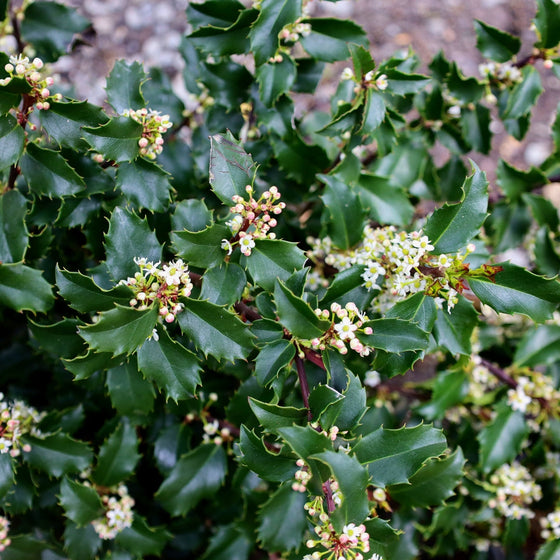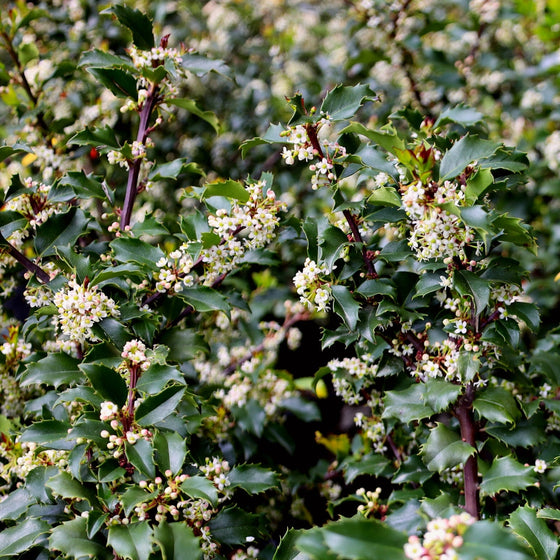
Images Depict Mature Plants
Blue Princess Holly Shrubs for Sale Online
Blue Princess Holly (Ilex x meserveae' Blue Princess') is a beautiful, hardy, evergreen shrub prized for its glossy, deep green foliage and abundant bright red berries. This female holly is known for its dense, bushy growth and striking berries that appear in the fall and persist through winter, adding vibrant color to the landscape when most other plants are dormant. Reaching a mature height of 8 to 12 feet and a width of 6 to 8 feet, Blue Princess is perfect for creating privacy screens, hedges, or a stunning accent in foundation plantings. Its ornamental value makes it a versatile choice for formal and informal gardens alike, providing both year-round structure and winter interest.
To ensure prolific berry production, Blue Princess Holly requires a male pollinator planted nearby, and Blue Prince Holly (Ilex x meserveae' Blue Prince') is the perfect match. Blue Prince blooms simultaneously with Blue Princess, providing the necessary pollen for successful fertilization, resulting in a showy display of bright red berries that attract birds and other wildlife. By planting Blue Prince within 30 to 50 feet of Blue Princess, you can ensure a reliable berry set each year, making your garden a lively destination for feathered friends during the colder months. The contrast of Blue Princess's vibrant berries against its glossy, blue-green leaves makes it a standout feature in any landscape, especially in winter.
Blue Princess Holly is highly adaptable to various growing conditions and thrives in full sun to partial shade, preferring slightly acidic, well-drained soil. It is also resistant to many pests and diseases and can tolerate urban pollution, making it an excellent low-maintenance choice for suburban and urban gardens. The dense foliage and thorny leaves also make Blue Princess an effective deterrent for unwanted wildlife and an excellent option for natural hedging or privacy screens. Whether used in mass plantings, as a foundation shrub, or as a specimen plant, Blue Princess Holly brings four-season beauty and ecological value to any landscape, offering rich color and texture throughout the year.

| Hardiness Zone: | 5-9 |
|---|---|
| Mature Height: | 8 to 12 Feet |
| Mature Width: | 6 to 8 Feet |
| Sunlight: | Full sun to part shade |
| Foliage Color: | Blue/green |
| Growth Form: | Upright |
| Soil: | Very tolerant of most soil conditions |
How to Care for Blue Princess Holly
Before you buy an Blue Princess Holly, make sure to read about the recommended care instructions to keep this Holly healthy and thriving.
How do I Plant a Blue Princess Holly?
To plant a Blue Princess Holly, begin by selecting a location with full sun to partial shade and well-drained, slightly acidic soil. Blue Princess Holly thrives in soil with a pH between 5.0 and 6.5, making it important to test the soil before planting to ensure the right conditions. Start by digging a hole twice as wide and just as deep as the root ball to give the roots enough room to spread and establish easily. Place the Blue Princess in the hole, ensuring the top of the root ball is level with the surrounding soil. Backfill the hole with the soil you removed, firming it around the roots to eliminate air pockets, and then water thoroughly to help the plant settle. The initial watering is essential for good root-to-soil contact and promotes healthy root establishment. After planting your Blue Princess Holly, apply a 2-3 inch layer of organic mulch around the base to help retain moisture, regulate soil temperature, and prevent weeds. Be careful to keep the mulch a few inches away from the trunk to prevent rot. Spacing is also important, particularly if you are planting multiple Blue Princess Hollies for a hedge or border; space them about 6 to 8 feet apart to allow for optimal growth and air circulation. For berry production, plant a compatible male pollinator like Blue Prince Holly within 30 to 50 feet of Blue Princess to ensure successful fertilization. With proper planting, mulching, and care, your Blue Princess Holly will grow into a beautiful evergreen shrub that adds year-round interest and bright berries in the winter.
How do I Water a Blue Princess Holly?
To water a Blue Princess Holly, it’s important to maintain consistent soil moisture, especially during the first growing season when the plant is establishing its root system. Water your Blue Princess deeply once or twice a week, depending on rainfall and soil conditions, to ensure the roots are receiving adequate moisture. The goal is to keep the soil evenly moist without becoming waterlogged, as Blue Princess Holly prefers well-drained soil. Using a slow, deep watering method, such as a soaker hose, is ideal for allowing the water to penetrate deeply, promoting strong root growth. During hot or dry spells, more frequent watering may be necessary to keep the shrub healthy and vibrant. Once established, Blue Princess Holly is more tolerant of occasional dry periods, but it will still benefit from regular watering, especially during prolonged heat or drought. Check the top few inches of soil—if it feels dry to the touch, it’s time to water. To help retain moisture and keep the roots cool, apply a 2-3 inch layer of organic mulch around the base of the shrub, keeping it a few inches away from the trunk to prevent rot. The mulch not only helps retain moisture but also reduces weed competition, giving your Blue Princess the best chance to thrive. Consistent and deep watering will keep your Blue Princess Holly healthy, ensuring it produces glossy foliage and abundant berries, especially when pollinated by a nearby Blue Prince Holly.
How do I Fertilize a Blue Princess Holly?
To fertilize a Blue Princess Holly, apply a balanced, slow-release fertilizer, such as 10-10-10 or 12-6-6, in early spring just before new growth begins. This timing ensures that the nutrients are readily available when the shrub needs them most for healthy growth and berry production. Spread the fertilizer evenly around the base of the plant, extending out to the drip line, which is the area under the outermost branches where the roots are actively growing. Avoid letting the fertilizer touch the trunk directly to prevent root burn. After applying the fertilizer, water the area thoroughly to help dissolve the nutrients and move them into the root zone where they can be absorbed effectively. For optimal results, it's beneficial to test the soil before fertilizing your Blue Princess Holly to determine its pH level, as holly shrubs prefer slightly acidic soil with a pH between 5.0 and 6.5. If your soil is too alkaline, consider adding Espoma Soil Acidifier to gradually lower the pH and create a more favorable environment for nutrient uptake. Supplementing with organic matter, such as compost or well-aged manure, is also a good idea, as it helps improve the overall soil structure and provides additional nutrients throughout the growing season. Avoid over-fertilizing, as this can lead to excessive vegetative growth at the expense of flower and berry production. Proper fertilization will ensure your Blue Princess Holly remains lush, healthy, and able to produce an abundant display of bright red berries, especially when paired with a nearby Blue Prince Holly for pollination.

How do I Prune a Blue Princess Holly?
To prune a Blue Princess Holly, it is best to do so in late winter or early spring, just before new growth begins. This timing allows you to shape the shrub and remove any dead, damaged, or diseased branches without interrupting the blooming process, which is crucial for berry production. Start by cutting away any broken or crossing branches to promote better air circulation and sunlight penetration, reducing the risk of disease. Use clean, sharp pruning shears to ensure smooth cuts, and trim back branches that are growing out of shape to maintain a dense, bushy form. Pruning at this time also encourages new growth, which will help keep your Blue Princess Holly looking lush and healthy. Light pruning throughout the growing season can also help maintain the shape and size of your Blue Princess Holly, particularly if you're using it for hedges or as a foundation planting. Avoid heavy pruning, as this can reduce the number of flowers and, consequently, the number of berries produced in the fall. Since Blue Princess relies on a nearby male pollinator, such as Blue Prince Holly, for berry production, maintaining a healthy and open structure ensures that the pollen can easily reach the female flowers. Regular pruning will help keep your Blue Princess Holly attractive and encourage an abundance of bright red berries that will enhance your landscape with beautiful winter interest.



















